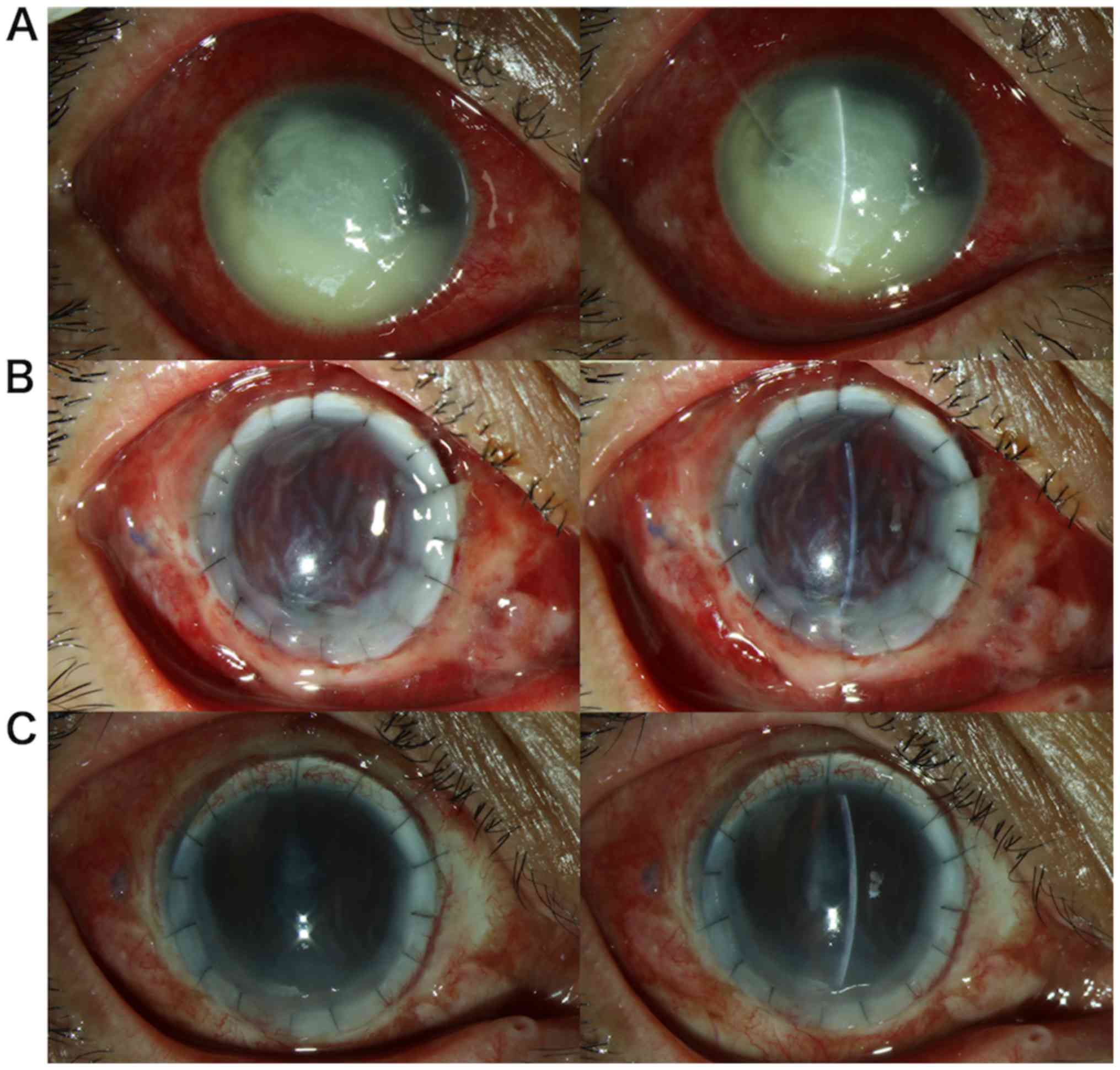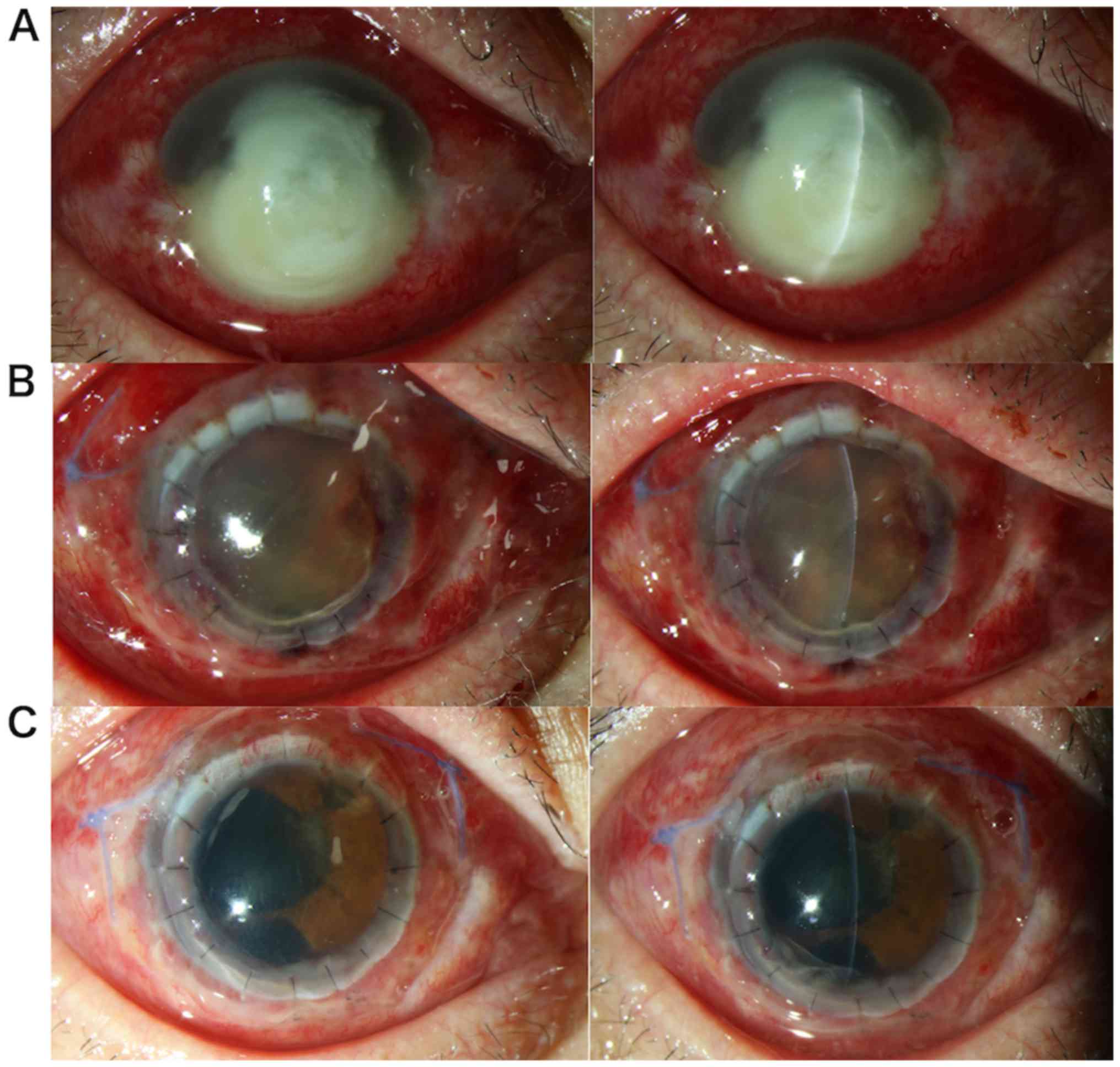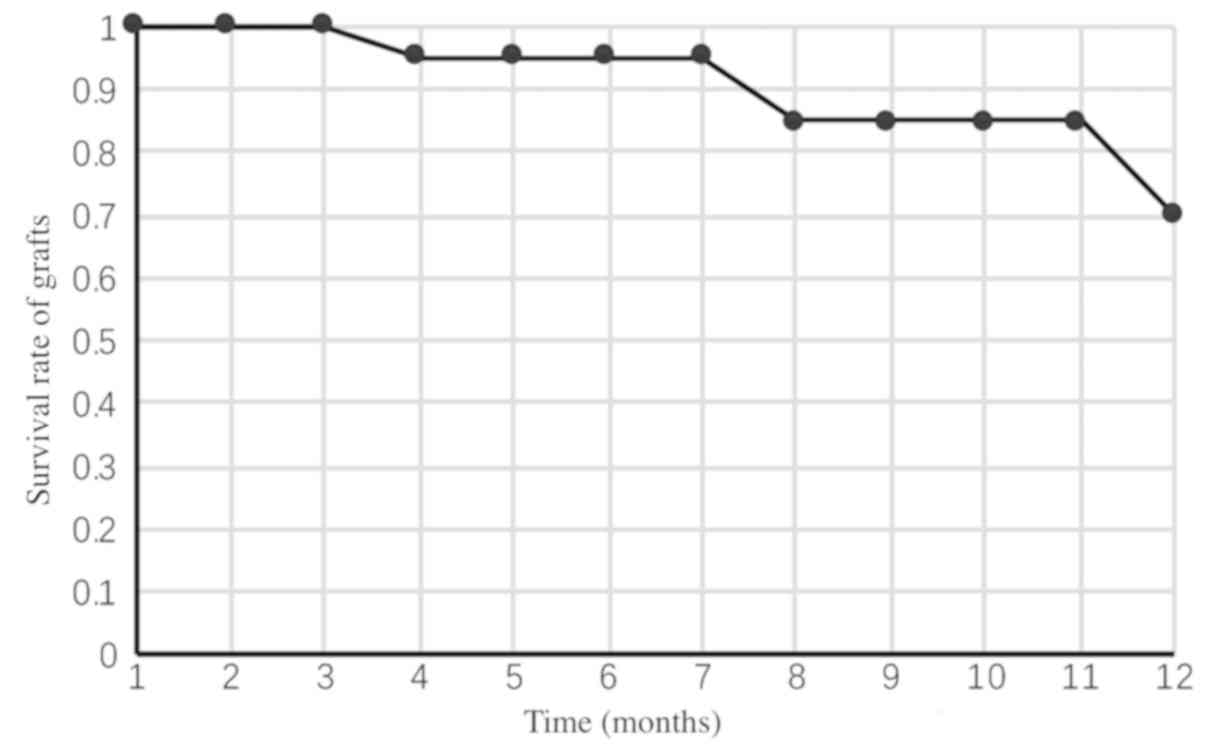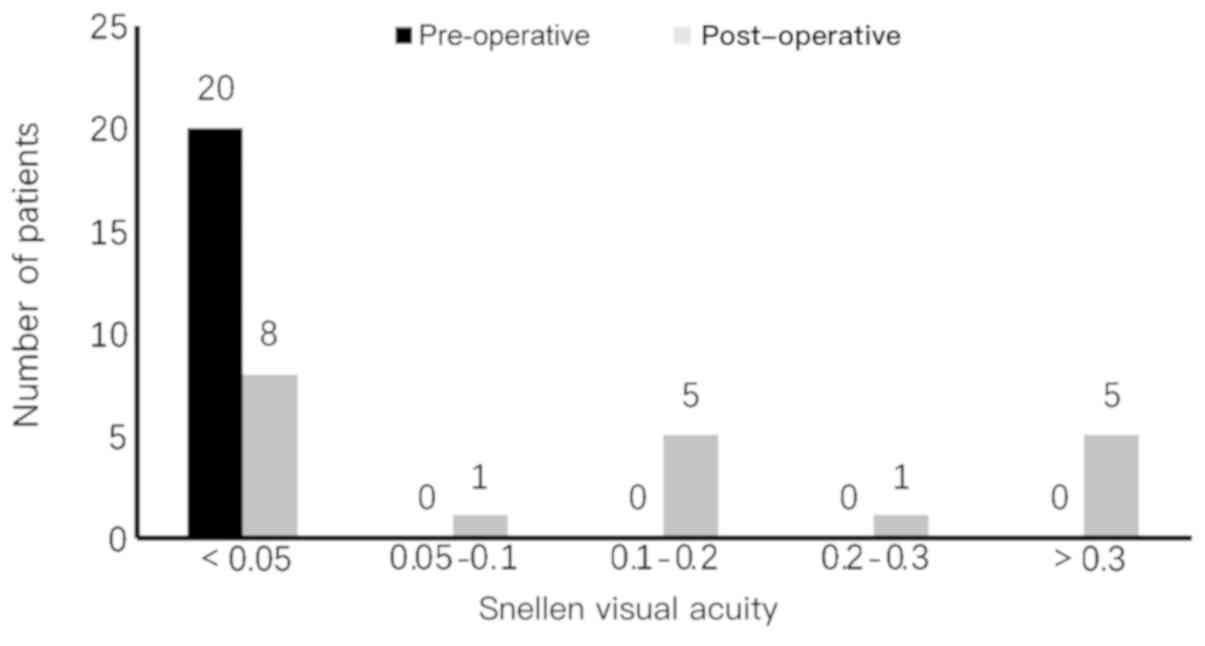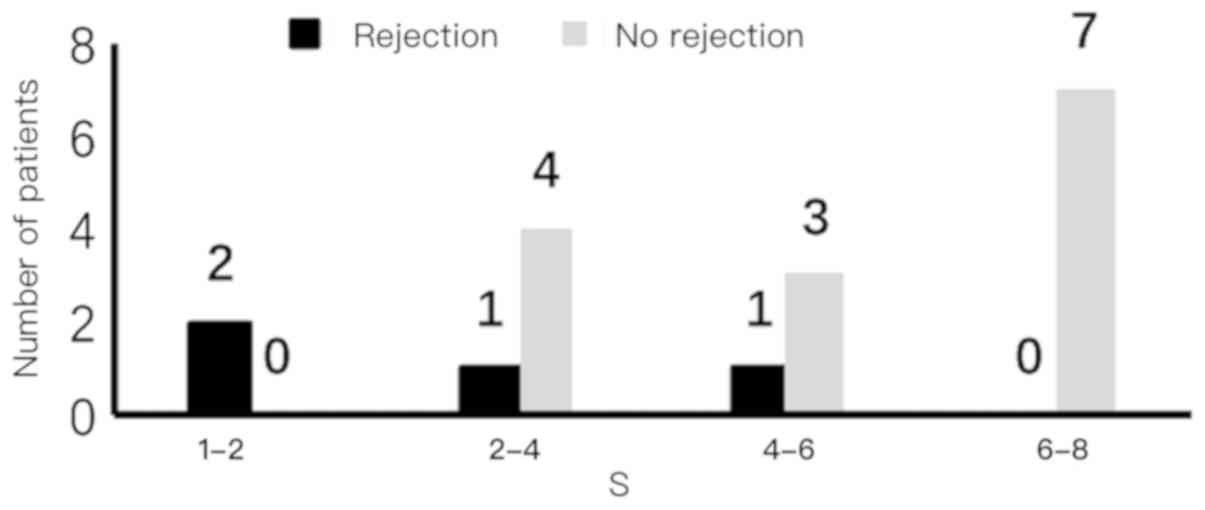|
1
|
Jones DB: Decision-making in the
management of microbial keratitis. Ophthalmology. 88:814–820.
1981.PubMed/NCBI View Article : Google Scholar
|
|
2
|
Yang JW, Lin HC, Hsiao CH and Chen PY:
Therapeutic penetrating keratoplasty in severe infective keratitis
using glycerol-preserved donor corneas. Cornea. 31:1103–1106.
2012.PubMed/NCBI View Article : Google Scholar
|
|
3
|
Ti SE, Scott JA, Janardhanan P and Tan DT:
Therapeutic keratoplasty for advanced suppurative keratitis. Am J
Ophthalmol. 143:755–762. 2007.PubMed/NCBI View Article : Google Scholar
|
|
4
|
Sharma N, Sachdev R, Jhanji V, Titiyal JS
and Vajpayee RB: Therapeutic keratoplasty for microbial keratitis.
Curr Opin Ophthalmol. 21:293–300. 2010.PubMed/NCBI View Article : Google Scholar
|
|
5
|
Cohen RA, Gebhardt BM and Bazan NG: A
platelet-activating factor antagonist reduces corneal allograft
inflammation and neovascularization. Curr Eye Res. 13:139–144.
1994.PubMed/NCBI View Article : Google Scholar
|
|
6
|
Rahman I, Carley F, Hillarby C, Brahma A
and Tullo AB: Penetrating keratoplasty: Indications, outcomes, and
complications. Eye (Lond). 23:1288–1294. 2009.PubMed/NCBI View Article : Google Scholar
|
|
7
|
Shi W, Wang T, Xie L, Li S, Gao H, Liu J
and Li H: Risk factors, clinical features, and outcomes of
recurrent fungal keratitis after corneal transplantation.
Ophthalmology. 117:890–896. 2010.PubMed/NCBI View Article : Google Scholar
|
|
8
|
MacMillan D: FK506 binding proteins:
Cellular regulators of intracellular Ca2+ signalling. Eur J
Pharmacol. 700:181–193. 2013.PubMed/NCBI View Article : Google Scholar
|
|
9
|
Magalhaes OA, Marinho DR and Kwitko S:
Topical 0.03% tacrolimus preventing rejection in high-risk corneal
transplantation: A cohort study. Br J Ophthalmol. 97:1395–1398.
2013.PubMed/NCBI View Article : Google Scholar
|
|
10
|
Wan Q, Tang J, Han Y, Wang D and Ye H:
Therapeutic effect of 0.1% tacrolimus eye drops in the tarsal form
of vernal keratoconjunctivitis. Ophthalmic Res. 59:126–134.
2018.PubMed/NCBI View Article : Google Scholar
|
|
11
|
Lee YJ, Kim SW and Seo KY: Application for
tacrolimus ointment in treating refractory inflammatory ocular
surface diseases. Am J Ophthalmol. 155:804–813. 2013.PubMed/NCBI View Article : Google Scholar
|
|
12
|
Tam PM, Young AL, Cheng LL and Lam PT:
Topical 0.03% tacrolimus ointment in the management of ocular
surface inflammation in chronic GVHD. Bone Marrow Transplant.
45:957–958. 2010.PubMed/NCBI View Article : Google Scholar
|
|
13
|
Abudou M, Wu T, Evans JR and Chen X:
Immunosuppressants for the prophylaxis of corneal graft rejection
after penetrating keratoplasty. Cochrane Database Syst Rev.
(CD007603)2015.PubMed/NCBI View Article : Google Scholar
|
|
14
|
Yamazoe K, Yamazoe K, Yamaguchi T, Omoto M
and Shimazaki J: Efficacy and safety of systemic tacrolimus in
high-risk penetrating keratoplasty after graft failure with
systemic cyclosporine. Cornea. 33:1157–1163. 2014.PubMed/NCBI View Article : Google Scholar
|
|
15
|
Miedziak AI, Miller MR, Rapuano CJ,
Laibson PR and Cohen EJ: Risk factors in microbial keratitis
leading to penetrating keratoplasty. Ophthalmology. 106:1166–1171.
1999.PubMed/NCBI View Article : Google Scholar
|
|
16
|
Skeens HM and Holland EJ: Large-diameter
penetrating keratoplasty: Indications and outcomes. Cornea.
29:296–301. 2010.PubMed/NCBI View Article : Google Scholar
|
|
17
|
Jia Y, Gao H, Li S and Shi W: Combined
anterior chamber washout, amniotic membrane transplantation, and
topical use of corticosteroids for severe peripheral ulcerative
keratitis. Cornea. 33:559–564. 2014.PubMed/NCBI View Article : Google Scholar
|
|
18
|
Cohen EJ, Kenyon KR and Dohlman CH:
Iridoplasty for prevention of post-keratoplasty angle closure and
glaucoma. Ophthalmic Surg. 13:994–996. 1982.PubMed/NCBI
|
|
19
|
Mannis MJ and Holland EJ: Cornea-surgery
of the cornea and conjunctiva. Fourth edition. Elsevier.
1,2(pp1952)2016.
|
|
20
|
Kharod-Dholakia B, Randleman JB, Bromley
JG and Stulting RD: Prevention and treatment of corneal graft
rejection: Current practice patterns of the Cornea Society (2011).
Cornea. 34:609–614. 2015.PubMed/NCBI View Article : Google Scholar
|
|
21
|
Jabs DA, Nussenblatt RB and Rosenbaum JT:
Standardization of Uveitis Nomenclature (SUN) Working Group.
Standardization of uveitis nomenclature for reporting clinical
data. Results of the first international workshop. Am J Ophthalmol.
140:509–516. 2005.PubMed/NCBI View Article : Google Scholar
|
|
22
|
Sloper CM, Powell RJ and Dua HS:
Tacrolimus (FK506) in the management of high-risk corneal and
limbal grafts. Ophthalmology. 108:1838–1844. 2001.PubMed/NCBI View Article : Google Scholar
|
|
23
|
Rinne JR and Stulting RD: Current
practices in the prevention and treatment of corneal graft
rejection. Cornea. 11:326–328. 1992.PubMed/NCBI View Article : Google Scholar
|
|
24
|
Williams KA, Roder D, Esterman A,
Muehlberg SM and Coster DJ: Factors predictive of corneal graft
survival. Report from the Australian corneal graft registry.
Ophthalmology. 99:403–414. 1992.PubMed/NCBI View Article : Google Scholar
|
|
25
|
Panda A, Vanathi M, Kumar A, Dash Y and
Priya S: Corneal graft rejection. Surv Ophthalmol. 52:375–396.
2007.PubMed/NCBI View Article : Google Scholar
|
|
26
|
Snyder RW, Sherman MD and Allinson RW:
Intracameral tissue plasminogen activator for treatment of
excessive fibrin response after penetrating keratoplasty. Am J
Ophthalmol. 109:483–484. 1990.PubMed/NCBI View Article : Google Scholar
|
|
27
|
Yu Y, Zhong J, Peng L, Wang B, Li S, Huang
H, Deng Y, Zhang H, Yang R, Wang C and Yuan J: Tacrolimus
downregulates inflammation by regulating pro-/anti-inflammatory
responses in LPS-induced keratitis. Mol Med Rep. 16:5855–5862.
2017.PubMed/NCBI View Article : Google Scholar
|
|
28
|
Sakuma S, Higashi Y, Sato N, Sasakawa T,
Sengoku T, Ohkubo Y, Amaya T and Goto T: Tacrolimus suppressed the
production of cytokines involved in atopic dermatitis by direct
stimulation of human PBMC system. (Comparison with steroids). Int
Immunopharmacol. 1:1219–1226. 2001.PubMed/NCBI View Article : Google Scholar
|
|
29
|
Flower RJ: Eleventh Gaddum memorial
lecture. Lipocortin and the mechanism of action of the
glucocorticoids. Br J Pharmacol. 94:987–1015. 1988.PubMed/NCBI View Article : Google Scholar
|
|
30
|
Ho S, Clipstone N, Timmermann L, Northrop
J, Graef I, Fiorentino D, Nourse J and Crabtree GR: The mechanism
of action of cyclosporin A and FK506. Clin Immunol Immunopathol.
80:S40–S45. 1996.PubMed/NCBI View Article : Google Scholar
|
|
31
|
Küchle M, Nguyen NX and Naumann GO:
Aqueous flare following penetrating keratoplasty and in corneal
graft rejection. Arch Ophthalmol. 112:354–358. 1994.PubMed/NCBI View Article : Google Scholar
|
|
32
|
Xie L and Shi W: Comparison of
immunological response after penetrating keratoplasty for three
kinds of infectious corneal ulcers. Chin J Ophthalmol. 18:249–251.
2000.(In Chinese).
|
|
33
|
Dandona L, Naduvilath TJ, Janarthanan M,
Ragu K and Rao GN: Survival analysis and visual outcome in a large
series of corneal transplants in India. Br J Ophthalmol.
81:726–731. 1997.PubMed/NCBI View Article : Google Scholar
|
|
34
|
Weisbrod DJ, Sit M, Naor J and Slomovic
AR: Outcome of repeat penetrating keratoplasty and risk factors for
graft failure. Cornea. 22:429–434. 2003.PubMed/NCBI View Article : Google Scholar
|
|
35
|
Li C, Zhao GQ, Che CY, Lin J, Li N, Jia
WY, Zhang QQ, Jiang N and Hu LT: Effect of corneal graft diameter
on therapeutic penetrating keratoplasty for fungal keratitis. Int J
Ophthalmol. 5:698–703. 2012.PubMed/NCBI View Article : Google Scholar
|
|
36
|
Price MO, Thompson RW Jr and Price FW Jr:
Risk factors for various causes of failure in initial corneal
grafts. Arch Ophthalmol. 121:1087–1092. 2003.PubMed/NCBI View Article : Google Scholar
|
|
37
|
Sukhija J and Jain AK: Outcome of
therapeutic penetrating keratoplasty in infectious keratitis.
Ophthalmic Surg Lasers Imaging. 36:303–309. 2005.PubMed/NCBI
|















